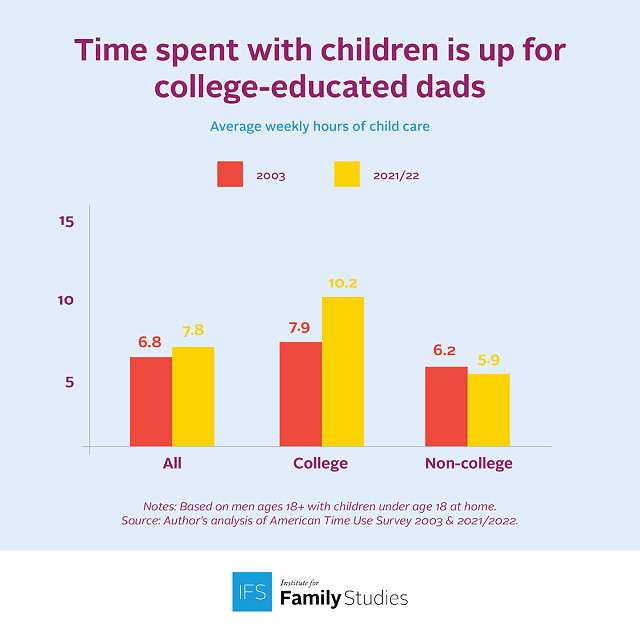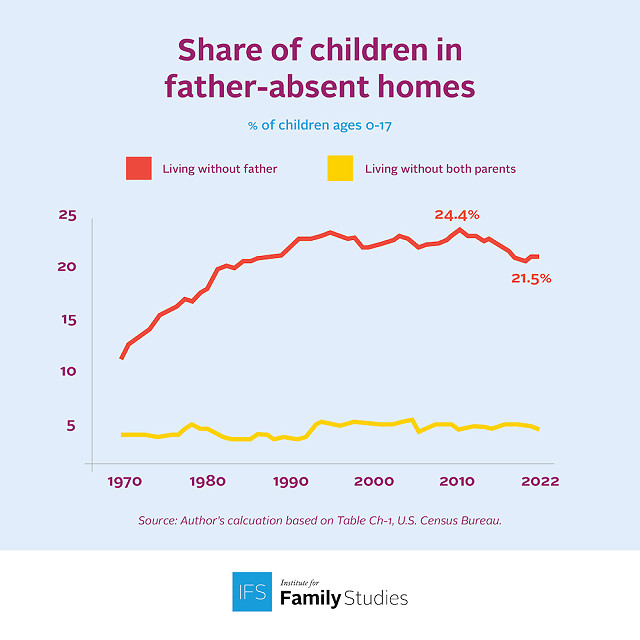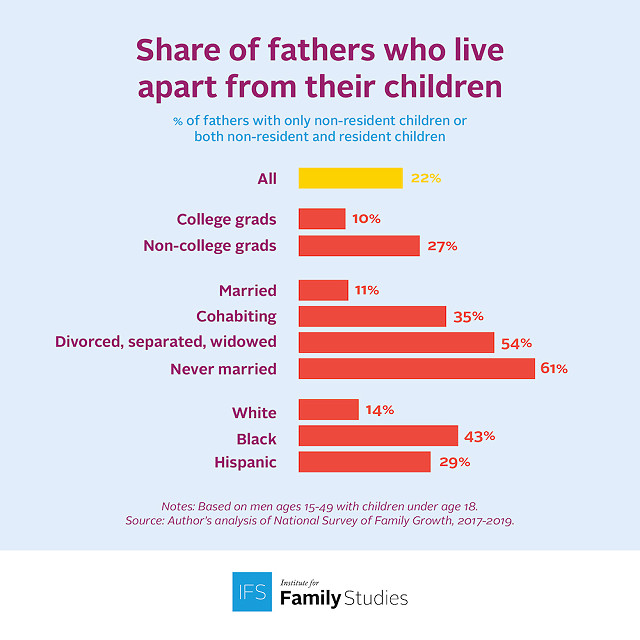Highlights
- In the past two decades, fathers' time with their children has increased the most among college-educated, partnered, white, or Asian dads, per a new IFS research brief. Post This
- Another recent trend for fathers and children in America involves a modest decline in the number of children living in father-absent homes. Post This
- American fathers are more involved in their children’s lives than ever. But the rise in fathers’ parenting time does not apply to all dads. Post This
- Whether or not a father lives apart from his children has a lot to do with his marital status. Post This
American fathers are more involved in their children’s lives than ever. Fathers in America now spend an average of 7.8 hours per week taking care of their children at home, up by 1 hour per week in just about two decades. (Mothers’ child care time remains stable during this period.) However, this rise in fathers’ parenting time does not apply to all dads. New time diary data from the federal government show that fathers' time with their children has increased the most in the past two decades among college-educated, partnered, white, or Asian dads.
College-educated fathers with children under age 18 at home now spend an average of 10 hours, 12 minutes a week on child care, up by more than 2 hours a week since 2003. At the same time, married fathers’ time with their children increased from 6.8 hours a week in 2003 to 8 hours a week in 2021/2022. (Cohabiting fathers’ time is up from an average of 5.1 hours to 6.7 hours a week.) Finally, child care time rose by about 1.8 hours per week for white fathers, and 2 hours per week for Asian fathers in the past two decades.

On the other hand, parenting time has been stagnant or even in decline for other dads. Fathers without a college degree now spend an average of 5.9 hours a week doing child care activities, down from 6.2 hours per week in 2003. Hispanic fathers’ time with their children decreased by about 1.2 hours per week in the past 2 decades. There is a small increase in child care time for black fathers since 2003, by about 20 minutes per week. There is barely any change in single fathers’ time with their children during the same period.
With these trends in place, the gap in fathers’ parenting time has widened by fathers’ education, marital status, and race/ethnicity. For example, college-educated fathers now spend almost twice the amount of time with their children as fathers without a college degree (10.2 hours per week vs. 5.9 hours per week). Back in 2003, the child care time difference between the two groups of fathers was less than 2 hours (7.9 hours vs. 6.2 hours per week).
Another recent trend for fathers and children in America involves a modest decline in the number of children living in father-absent homes. Over the past decade, the number of children under age 18 who lived without a father or both parents decreased from 20.6 million in 2012 to 18.4 million in 2022, according to data from the U.S. Census Bureau. The share of children living without a father (but with a single mother) dropped from 24.4% to 21.5 % between 2012 and 2022. The share of children who live without both parents remained stable, but the share living with both parents increased from 68% to 70% during the same period.

Likewise, the share of fathers who live apart from their children also experienced a slight decrease. Some 27% of fathers had (at least) one child under age 18 who didn’t live with them in 2006-2008; the share is down to 23% in 2017-2019, according to other federal data collected by the National Center for Health Statistics.
The time non-resident fathers spend with their children is only a fraction of that spent by residential fathers. Time diary data suggest that non-resident fathers spent an average of 0.6 hours (36 mins) per week with their children in 2021/2022, compared with 7.8 hours per week for fathers who live with their children. Estimates from a traditional survey asking about frequencies of specific activities of fathers with their children also suggest that fathers who live with their children are more involved in their children’s lives than non-resident fathers.
Whether or not a father lives apart from his children has a lot to do with his marital status. The majority of never-married fathers (61%) as well as divorced fathers (53%) live separately from their children, compared with 36% of cohabiting fathers and only 11% of married fathers.

Fathers’ educational level and race/ethnicity are also linked to the likelihood of living apart from their children. Fathers without a college degree are three times more likely than college-educated fathers to live apart from their children (27% vs. 10%). Black fathers are much more likely to have non-resident children than white fathers (43% vs. 14%), and the share of non-resident Hispanic fathers is in the middle (29%).
Overall, 44% of non-resident fathers reported that they saw or visited their children regularly in the past month (at least once a week). Black non-resident fathers (59%) are more likely than white (39%) or Hispanic fathers (35%) to see their children regularly. College-educated fathers are also more engaged with their non-resident children than non-college educated fathers (56% vs. 42%).
In contrast, fathers who are currently married or living with a partner are less likely than fathers who are either divorced or never married to see their non-resident children on a regular basis. This may be linked to their relationship with their non-resident children’s mother as well as to their responsibilities to their new family. In fact, currently married or cohabiting fathers who have non-resident children are less likely than their never-married or divorced peers to say that they and their (non-resident) children’s mother are a good parenting team. In addition, married or cohabiting non-resident fathers are more likely than never-married or divorced non-resident fathers also to have children who live at home with them, which splits their time and attention in parenting.
Among the other key findings:
- The child care gap between college and non-college educated fathers is more pronounced in interactive activities such as playing, talking, and reading to children as well as activities related to children’s basic needs (e.g., diapering and feeding). College-educated fathers spend an average of 4.2 hours per week in interactive activities, compared with 2.6 hours per week for fathers without a college degree. Their time taking care of children’s physical needs is also significantly higher than their peers without a college degree (3.7 hours per week vs. 1.9 hours per week).
- Married fathers spend twice as much time in managerial child care activities, such as planning activities and picking up/dropping off their children, than cohabiting fathers (1.5 hours per week vs. 0.6 hours per week). In addition, married fathers also spend more time than cohabiting fathers helping with their children’s homework or other school activities.
- Asian fathers spend more time in all child care activities than do other fathers, especially in basic child care activities. Asian fathers spend an average of 4.7 hours per week taking care of their children’s basic needs, compared with 2.8 hours per week for white fathers, 2.3 hours per week for black fathers, and 1.9 hours per week for Hispanic fathers.
- More than 7-in-10 non-resident fathers reported paying child support on a regular basis. College-educated, married, or divorced non-resident fathers are more likely than other non-resident fathers to pay child support on a regular basis. Non-resident fathers of different races and ethnicities are about equally likely to pay child support.
- The combined data of resident and non-resident fathers show that college-educated dads and married dads are more likely to be highly involved, with about 90% of dads in each of these two groups seeing their children daily. In contrast, only half of never-married fathers see their children at least once a day.
Download the full research brief.












